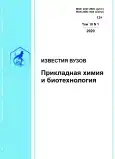Full-genome sequencing of the Staphylococcus warneri strain isolated from oil-contaminated soil
- Authors: Degtyareva I.A.1,2, Babynin E.V.3,1, Motina T.Y.1, Sultanov M.I.1
-
Affiliations:
- Tatar Research Institute of Agrochemistry and Soil Science, the “Kazan Scientific Centre of the Russian Academy of Sciences” Federal Research Centre
- Kazan National Research Technological University
- Kazan Federal University
- Issue: Vol 10, No 1 (2020)
- Pages: 48-55
- Section: Physico-chemical biology
- URL: https://journal-vniispk.ru/2227-2925/article/view/299264
- DOI: https://doi.org/10.21285/2227-2925-2020-10-1-48-55
- ID: 299264
Cite item
Full Text
Abstract
About the authors
I. A. Degtyareva
Tatar Research Institute of Agrochemistry and Soil Science, the “Kazan Scientific Centre of the Russian Academy of Sciences” Federal Research Centre; Kazan National Research Technological University
Email: peace-1963@mail.ru
E. V. Babynin
Kazan Federal University; Tatar Research Institute of Agrochemistry and Soil Science, the “Kazan Scientific Centre of the Russian Academy of Sciences” Federal Research Centre
Email: edward.b67@mail.ru
T. Yu. Motina
Tatar Research Institute of Agrochemistry and Soil Science, the “Kazan Scientific Centre of the Russian Academy of Sciences” Federal Research Centre
Email: motina.tatyana@mail.ru
M. I. Sultanov
Tatar Research Institute of Agrochemistry and Soil Science, the “Kazan Scientific Centre of the Russian Academy of Sciences” Federal Research Centre
Email: niiaxp2@mail.ru
References
- Hu G., Li J., Zeng G. Recent development in the treatment of oily sludge from petroleum industry: a review // Journal of Hazardous Materials. 2013. Vol. 261. P. 470–490. https://doi.org/10.1016/j.jhazmat.2013.07.069
- Fuentes S., Méndez V., Aguila P., Seeger M.Bioremediation of petroleum hydrocarbons: catabolic genes, microbial communities, and applications // Applied Microbiology and Biotechnology. 2014. Vol. 98. Issue 11. P. 4781–4794. https://doi.org/10.1007/s00253-014-5684-9
- Дегтярева И.А., Яппаров И.А., Яппаров А.Х., Ежкова А.М., Давлетшина А.Я., Шайдуллина И.А. Создание и применение биоудобрения на основе эффективного консорциума микроорганизмов-деструкторов для рекультивации нефтезагрязненных почв Республики Татарстан // Нефтяное хозяйство. 2017. N. 5. С. 100–103. https://doi.org/10.24887/0028-2448-2017-5-100-103
- Juwarkar A.A., Misra R.R., Sharma J.K. Re-cent trends in bioremediation. In: Parmar N., Singh A. (eds.). Geomicrobiology and Biogeochemistry. Berlin: Springer. 2014. P. 81–100.
- Дегтярева И.А., Давлетшина А.Я. Применение консорциума аборигенных углеводородокисляющих микроорганизмов для ремедиации черноземной и серой лесной почв Республики Татарстан // Вестник Казанского технологического университета. 2015. Т. 18. N. 4. С. 275–278.
- Brooijmans R.J.W., Pastink M.I., Siezen R.J. Hydrocarbon-degrading bacteria: the oil-spill clean-up crew // Microbial Biotechnology. 2009. Vol. 2. Issue 6. P. 587–594. https://doi.org/10.1111/j.1751-7915.2009.00151.x
- Carmona M., Zamarro M.T., Blazquez B., Durante-rodriguez G., Juarez J.F., Valderrama J.A., et al. Anaerobic catabolism of aromatic compounds: a genetic and genomic view // Microbiology and Molecular Biology Reviews. 2009. Vol. 73. Issue 1. P. 71– 133. https://doi.org/10.1128/MMBR.00021-08
- Дегтярева И.А., Хидиятуллина А.Я. Оценка влияния природных ассоциаций углеводородокисляющих микроорганизмов на состояние нефтезагрязненной почвы // Ученые записки Казанского университета. 2011. Т. 153. N. 3. С. 137–143.
- Moscoso F., Teijiz I., Deive F.J., Sanromán M.A. Efficient PAHs biodegradation by a bacterial consortium at flask and bioreactor scale // Bioresource Technology. 2012. Vol. 119. P. 270–276. https://doi.org/10.1016/j.biortech.2012.05.095
- M’rassi A.G., Bensalah F., Gury J., Duran R. Isolation and characterization of different bacterial strains for bioremediation of n-alkanes and polycyclic aromatic hydrocarbons // Environmental Science and Pollution Research. 2015. Vol. 22. Is-sue 20. P. 15332–15346. https://doi.org/10.1007/s11356-015-4343-8
- Bhardwaj B., Bhatnagar U.B., Conaway D. G. An unusual presentation of native valve endocarditis caused by Staphylococcus warneri // Reviews in Cardiovascular Medicine. 2016. Vol. 17. Issue 3-4. P. 140–143. https://doi.org/10.3909/ricm0823
- Godini K., Samarghandi M.R., Zafari D., Rahman A.R., Afkhami A., Arabestani M.R. Isolation and identification of new strains of crude oil degrading bacteria from Kharg Island, Iran // Petroleum Science and Technology. 2018. Vol. 36. Issue 12. P. 869–874. https://doi.org/10.1080/10916466.2018.1447961
- Popowicz G.M., Dubin G., Stec-Niemczyk J., Czarny A., Dubin A.D., Potempa J., et al. Functional and structural characterization of Sp1 protease from Staphylococcus aureus // Journal of Molecular Biology. 2006. Vol. 358. Issue 1. P. 270–279. https://doi.org/10.1016/j.jmb.2006.01.098
- Eddouaouda K., Mnif S., Badis A., Younes S.B., Cherif S., Ferhat S., et al. Characterization of a novel biosurfactant produced by Staphylococcus sp. strain 1E with potential application on hydrocarbon bioremediation // Journal of Basic Microbiology. 2012. Vol. 52. Issue 4. P. 408–418. https://doi.org/10.1002/jobm.201100268
- Bankevich A., Nurk S., Antipov D., Gurevich A., Dvorkin M., Kulikov A., et al. SPAdes: a new genome assembly algorithm and its applications to single-cell sequencing // Journal of Computational Biology. 2012. Vol. 19. P. 455–477. https://doi.org/10.1089/cmb.2012.0021
- Brettin T., Davis J.J., Disz T., Edwards R.A., Gerdes S., Olsen G.J., et al. RASTtk: a modular and extensible implementation of the RAST algorithm for building custom annotation pipelines and annotating batches of genomes // Scientific Reports. 2015. Vol. 5. P. 8365. https://doi.org/10.1038/srep08365
- Overbeek R., Olson R., Pusch G.D., Olsen G.J., Davis J.J., et al. The SEED and the rapid annotation of microbial genomes using subsystems technology (RAST) // Nucleic Acids Research. 2014. Vol. 42. P. D206–D214. https://doi.org/10.1093/nar/gkt1226
- Mesarch M.B., Nakatsu C.H., Nies L. Development of catechol 2,3-dioxygenase-specific primers for monitoring bioremediation by competitive quantitative PCR // Applied and Environmen Microbiology. 2000. Vol. 66. Issue 2. P. 678–683. https://doi.org/10.1128/aem.66.2.678-683.2000
- Pérez-Pantoja D., González B., Pieper D.H. Aerobic degradation of aromatic hydrocarbons. In: Timmis K.N. (eds.). Handbook of Hydrocarbon and Lipid Microbiology. Berlin: Springer, 2010. P. 799–837.
- Sierra-Garcia I.N., Alvarez J.C., de Vasconcellos S.P., de Souza A.P., dos Santos Neto E.V., de Oliveira V.M. New hydrocarbon degradation pathways in the microbial metagenome from Brazilian petroleum reservoirs // Public Library of Science. 2014. Vol. 9. Issue 2. P. e90087. https://doi.org/10.1371/journal.pone.0090087
Supplementary files









